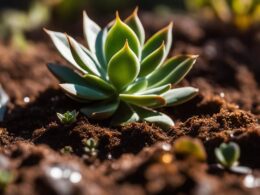Are you considering growing potted sunflowers but wondering how long they will last? Look no further, because in this article, we will provide you with all the information you need to ensure the longevity of your potted sunflowers.
Potted sunflowers can bring vibrant beauty and joy to any space, but it’s essential to understand how to care for them properly. By choosing the right pot and soil, providing adequate sunlight and water, monitoring pests and diseases, pruning and deadheading, supporting and staking, harvesting sunflower seeds, and replanting, you can extend the lifespan of your potted sunflowers.
With these simple tips and techniques, you can enjoy the beauty and benefits of your potted sunflowers for an extended period, while also ensuring their safety and well-being. So, let’s get started and make your potted sunflowers thrive!
Quick Summary
- The lifespan of potted sunflowers depends on various factors such as proper watering, adequate sunlight, and regular fertilization.
- Choosing a healthy plant with vibrant green leaves and sturdy stems is important for ensuring the longevity of potted sunflowers.
- Regular pruning and deadheading of potted sunflowers promotes healthy growth and encourages more blooms.
- Providing support with stakes or plant cages prevents potted sunflowers from falling over and ensures their longevity.
Lifespan of Potted Sunflowers
How long do your potted sunflowers typically last? The lifespan of potted sunflowers can vary depending on several factors. By following these care tips, you can help ensure that your sunflowers last as long as possible.
First and foremost, it’s important to choose a healthy plant from the start. Look for sunflowers with vibrant green leaves and sturdy stems. This will give your potted sunflowers a better chance at a longer lifespan.
Proper watering is crucial for the longevity of your potted sunflowers. Overwatering can lead to root rot, while underwatering can cause the plant to wither. Find the right balance by checking the moisture level of the soil regularly. Water your sunflowers when the top inch of soil feels dry to the touch.
Sunflowers are known for their love of sunlight, so make sure to place your potted sunflowers in a spot where they can receive at least six hours of direct sunlight each day. Additionally, rotate the pots every few days to ensure even growth.
Lastly, regular fertilization can help extend the lifespan of your potted sunflowers. Use a balanced, slow-release fertilizer to provide the necessary nutrients for healthy growth.
By considering these lifespan factors and following these care tips, you can enjoy your potted sunflowers for a longer period of time. Happy gardening!
Choosing the Right Pot and Soil
When choosing the right pot for your potted sunflowers, make sure to select an appropriate pot size that allows for proper root development and growth. Using well-draining soil is essential to prevent waterlogged roots and ensure the health of your sunflowers.
Don’t forget to add fertilizer and nutrients to provide the necessary nourishment for your potted sunflowers to thrive.
Selecting the Appropriate Pot Size
Choose a pot that’s just right for your sunflowers to thrive and show off their vibrant beauty. When selecting the appropriate pot size, it’s important to consider the needs of your sunflowers. Start by choosing a pot that is at least 10 to 12 inches deep and wide enough to accommodate the sunflower’s root system. This will allow the roots to spread out and establish a strong foundation.
Additionally, make sure the pot has proper drainage holes to prevent waterlogged soil, which can lead to root rot. To ensure proper drainage, use a potting mix specifically designed for potted sunflowers. This mix should be well-draining and lightweight, allowing water to flow freely through the soil and preventing excess moisture buildup.
By selecting the right potting mix and ensuring proper drainage, you can create an ideal environment for your potted sunflowers to thrive and flourish.
Using Well-Draining Soil
To ensure your potted sunflowers thrive, make sure you use well-draining soil that allows water to flow freely and prevents excess moisture buildup.
Improving drainage is crucial for the health of your sunflowers. When water sits in the pot, it can lead to root rot and other diseases that can harm your plants. Using well-draining soil helps prevent this by allowing excess water to escape. It also helps with moisture retention, ensuring that your sunflowers get enough water without becoming waterlogged.
When choosing soil for your potted sunflowers, look for a mix that contains perlite or vermiculite, as these materials aid in drainage. Remember, keeping your sunflowers happy and healthy starts with providing them with the right kind of soil.
Adding Fertilizer and Nutrients
Adding fertilizer and nutrients to your potted sunflowers is like giving them a nourishing meal that helps them grow strong and vibrant. Fertilizer benefits your sunflowers by providing essential nutrients like nitrogen, phosphorus, and potassium. These nutrients promote healthy root growth, sturdy stems, and vibrant blooms.
However, it’s important to choose the right fertilizer for potted plants, as too much can harm them. Organic alternatives, such as compost or well-rotted manure, are safer options. They provide a slow release of nutrients, ensuring a steady supply for your sunflowers without the risk of burning their roots.
When applying fertilizer, always follow the package instructions and avoid overfeeding. Remember, a balanced and controlled approach to fertilizing will keep your potted sunflowers healthy and thriving.
Providing Adequate Sunlight and Water
To ensure the health and vitality of your potted sunflowers, it’s crucial to provide them with adequate sunlight. Sunflowers thrive in full sun, so make sure they get at least six to eight hours of direct sunlight each day.
Additionally, it’s important to water your potted sunflowers regularly. Be cautious not to overwater or underwater them. Find the right balance by watering them when the top inch of soil feels dry. Make sure the water reaches the roots but doesn’t leave the soil waterlogged.
Sunlight Requirements for Potted Sunflowers
Did you know that potted sunflowers thrive best when they receive ample sunlight? Sunlight is essential for the growth and development of sunflowers, and it is important to provide them with the right amount of light to ensure their well-being. Sunflower care involves placing the potted plants in an area where they can receive at least 6-8 hours of direct sunlight each day. This can be achieved by placing them near a south-facing window or in a sunny spot outdoors. It is also important to regularly rotate the pots to ensure that all sides of the sunflowers receive equal sunlight. By providing adequate sunlight, you can ensure that your potted sunflowers stay healthy and vibrant for a longer period of time.
| Sunlight Requirements for Potted Sunflowers | |
|---|---|
| Sunlight Duration | 6-8 hours/day |
| Placement | South-facing window or sunny spot outdoors |
| Rotation | Regularly rotate pots for equal sunlight exposure |
Watering Guidelines and Frequency
Watering the potted sunflowers regularly and following the proper guidelines will ensure their healthy growth and vibrant appearance. To keep your sunflowers thriving, here are some essential watering techniques:
-
Water thoroughly: When watering, make sure to soak the soil until it’s evenly moist. This helps the roots absorb the water effectively.
-
Allow proper drainage: Ensure that your potted sunflowers have drainage holes to prevent waterlogged soil, which can lead to root rot.
-
Monitor signs of overwatering: Overwatering can be detrimental to sunflowers. Look out for yellowing leaves, wilting, or a foul odor, indicating excess moisture.
By adhering to these watering guidelines, you’ll help your potted sunflowers flourish. Remember, it’s better to slightly underwater than overwater. With proper care, your sunflowers will grace your space with their vibrant blooms for a long time.
Avoiding Overwatering and Underwatering
Finding the right balance of moisture is crucial for the health and vibrancy of your sunflowers, ensuring their stunning beauty fills your heart with joy.
To avoid root rot and signs of overwatering, it’s important to understand the watering needs of potted sunflowers. Overwatering can lead to soggy soil, which suffocates the roots and promotes the growth of harmful fungi. To prevent this, make sure the pot has good drainage and only water when the top inch of soil feels dry.
On the other hand, underwatering can cause the sunflowers to wilt and their leaves to turn yellow. To avoid this, check the soil regularly and water thoroughly when needed, making sure the water reaches the roots.
By following these guidelines, you can maintain the perfect moisture balance for your potted sunflowers, ensuring their long-lasting beauty.
Monitoring and Managing Pests and Diseases
Monitoring and managing pests and diseases is crucial in ensuring the longevity of potted sunflowers. By taking the necessary precautions, you can prevent common sunflower pests from wreaking havoc on your plants and stop diseases from spreading.
Here are some tips to keep your sunflowers safe:
-
Identify and manage pests: Regularly inspect your sunflowers for signs of common pests like aphids, caterpillars, and spider mites. If you spot any, take immediate action to remove them. Use organic insecticides or natural remedies like neem oil to control the infestation. Remember to follow the instructions carefully to avoid harming yourself or the environment.
-
Practice good hygiene: Keep your potted sunflowers clean and tidy. Remove any fallen leaves or debris that may harbor pests or diseases. Regularly sanitize your gardening tools to prevent the spread of pathogens.
-
Provide optimal growing conditions: Sunflowers thrive in well-draining soil and require proper sunlight and air circulation. Avoid overcrowding your potted sunflowers, as it can create a favorable environment for diseases. Water your plants at the base and avoid wetting the leaves, as excessive moisture can lead to fungal infections.
By following these guidelines and actively monitoring your potted sunflowers, you can effectively manage pests and diseases, ensuring a longer lifespan for your beautiful plants.
Pruning and Deadheading
To promote healthy growth and encourage more blooms, regularly pruning and deadheading your potted sunflowers is essential. Pruning involves cutting back certain parts of the plant to remove dead or diseased material, improve airflow, and shape the sunflower’s growth. Deadheading, on the other hand, refers to the removal of spent flowers to encourage new blooms and prevent the plant from wasting energy on seed production. Both techniques are simple tasks that can greatly benefit your potted sunflowers.
When it comes to pruning, it’s important to use clean and sharp tools to minimize the risk of spreading diseases. Start by removing any dead or damaged leaves, stems, or flowers. Trim back any excessively long or unruly branches to maintain a compact and well-balanced plant. Additionally, thin out crowded areas to improve air circulation and reduce the risk of fungal diseases.
As for deadheading, it’s best to do it regularly throughout the flowering season. Simply snip off the faded flowers just above a leaf node or bud. This will stimulate the production of new blooms and keep your sunflowers looking fresh and vibrant.
By incorporating these pruning techniques and emphasizing the importance of deadheading, you can ensure that your potted sunflowers stay healthy, beautiful, and continue to bloom throughout their lifespan.
| Pruning Techniques | Importance of Deadheading | ||
|---|---|---|---|
| Remove dead or damaged material | Stimulate new bloom production | ||
| Improve air circulation | Prevent wasted energy on seed production | ||
| Maintain plant shape and balance | Keep sunflowers looking fresh and vibrant | ||
| Reduce risk of fungal diseases | Encourage healthy growth | ||
| Use clean and sharp tools | Promote overall plant health | Prune away any dead or damaged leaves or stems regularly. |
Supporting and Staking
When supporting and staking your sunflowers, you’ll need to provide them with a sturdy structure to prevent them from falling over and ensure their stems grow strong and straight. Supporting techniques and staking methods are crucial for maintaining the health and stability of your potted sunflowers.
One effective method for supporting sunflowers is using stakes. Choose stakes that are tall enough to reach the desired height of your sunflowers. Place the stakes around the outer edges of the pot, evenly spaced, and gently push them into the soil. Make sure the stakes are secure and firmly anchored.
Next, tie the sunflower stems to the stakes using soft plant ties or twine. Start at the base of the stem and loosely wrap the tie around the stem and stake, allowing room for growth. Avoid tying the stems too tightly, as it may restrict their natural development.
Another supporting technique is using plant cages. These cages are made of wire or plastic and provide a stable framework for the sunflowers to grow through. Place the cage over the sunflower seedling and gently guide the stems through the openings. As the sunflowers grow, they will naturally fill out the cage, ensuring they remain upright and supported.
Remember to regularly check the ties and stakes, adjusting them as needed to accommodate the growth of your sunflowers. By providing proper support and staking, you can help your potted sunflowers thrive and enjoy their beautiful blooms for as long as possible.
What Is the Lifespan of Potted Gerbera Daisies Compared to Sunflowers?
When it comes to comparing the lifespan of potted gerbera daisies and sunflowers, the potted gerbera daisies lifespan explained can provide some insights. Generally, potted gerbera daisies have a longer lifespan compared to sunflowers when cultivated indoors. While sunflowers typically last for a couple of weeks, potted gerbera daisies can thrive for several months with proper care and maintenance.
Harvesting and Enjoying Sunflower Seeds
Now that you’ve learned about supporting and staking your potted sunflowers, it’s time to move on to the exciting part: harvesting and enjoying sunflower seeds! Harvesting sunflower seeds is not only a fun and rewarding experience, but it also allows you to enjoy the delicious and nutritious benefits of these seeds.
To help you make the most of your sunflower harvest, let’s talk about some harvesting techniques and roasting methods. When it comes to harvesting, it’s important to wait until the back of the sunflower head turns brown and the seeds are plump and firm. This indicates that the seeds are fully mature and ready to be harvested.
Once you’ve harvested your sunflower heads, you’ll need to remove the seeds from the flower head. To do this, you can use your hands or a fork to gently pry the seeds loose. It’s important to handle the seeds with care to avoid damaging them.
After you’ve separated the seeds from the flower head, it’s time to roast them for a delicious snack. Roasting sunflower seeds not only enhances their flavor but also helps to remove any excess moisture. You can roast them in the oven or on the stovetop with a little bit of oil and salt for added flavor.
Table:
| Harvesting Techniques | Roasting Methods |
|---|---|
| Wait until the back of the sunflower head turns brown and the seeds are plump and firm | Roast them in the oven or on the stovetop with a little bit of oil and salt |
| Gently pry the seeds loose from the flower head using your hands or a fork | Roasting enhances the flavor and removes excess moisture |
By following these harvesting techniques and roasting methods, you can enjoy the delicious and nutritious sunflower seeds from your potted sunflowers. Remember to handle the seeds with care and always prioritize safety when enjoying this delightful treat!
Replanting and Reproducing Potted Sunflowers
Replanting and reproducing potted sunflowers can be a fascinating and rewarding experience for garden enthusiasts. If you’re interested in expanding your sunflower collection or simply want to enjoy the beauty of these flowers year after year, learning the proper replanting techniques and propagating methods is essential.
To begin, it’s important to choose a healthy sunflower plant with strong stems and vibrant blooms. Once you’ve selected the right candidate, gently remove it from its current pot, being careful not to damage the roots. Prepare a new pot with nutrient-rich soil, ensuring it has good drainage. Place the sunflower in the center of the pot and fill in the surrounding area with soil, lightly patting it down.
To propagate your potted sunflower, you can also collect seeds from the flower head. Allow the sunflower to fully mature and dry out before harvesting the seeds. Once you’ve collected the seeds, store them in a cool, dry place until you’re ready to use them.
When replanting or propagating sunflowers, it’s essential to provide them with adequate sunlight, water, and nutrients. Regularly check the soil moisture and adjust watering accordingly. Additionally, consider using organic fertilizers to promote healthy growth.
By following these replanting techniques and propagating methods, you can enjoy the beauty of potted sunflowers for years to come. Remember to always prioritize safety and enjoy the process of growing your own sunflower collection.
Frequently Asked Questions
Can potted sunflowers be grown indoors?
Yes, potted sunflowers can be grown indoors. Indoor sunflower gardening has many benefits, such as adding beauty to your home and improving air quality. With proper care, they can thrive and bring joy for weeks or even months.
How often should I water my potted sunflowers?
To prevent overwatering potted sunflowers, water them when the top inch of soil feels dry. Signs of underwatering include wilting and dry soil. Regularly check the moisture level and adjust watering accordingly for healthy, long-lasting sunflowers.
Do potted sunflowers require fertilization?
Yes, potted sunflowers require fertilization. Fertilization benefits their growth and overall health. The best fertilizers for potted sunflowers include balanced formulas with nutrients like nitrogen, phosphorus, and potassium.
What are some common pests and diseases that affect potted sunflowers?
To keep your potted sunflowers safe from pests and diseases, watch out for aphids infestation and powdery mildew outbreaks. Regularly inspect your plants and treat any issues promptly to ensure their health and longevity.
Can potted sunflowers be planted directly into the ground?
Yes, you can transplant potted sunflowers directly into the ground. It’s actually beneficial because they can grow bigger and stronger with more space and access to nutrients.
Conclusion
In conclusion, taking care of potted sunflowers can be a rewarding experience. By choosing the right pot and soil, providing adequate sunlight and water, and monitoring for pests and diseases, you can help prolong the lifespan of your sunflowers. Additionally, performing regular pruning and deadheading, supporting and staking the plants, and harvesting and enjoying the sunflower seeds are all important steps. If you want to keep the sunflower magic going, you can even replant and reproduce them. So go ahead, enjoy the beauty and benefits of potted sunflowers for as long as possible!









